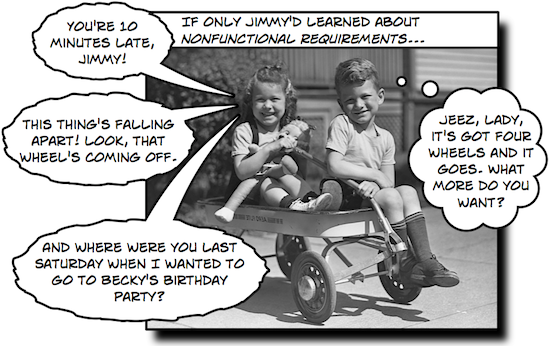Jenny and I love hearing from our readers, and we got this excellent question yesterday from a Learning Agile reader (which I’ve edited a bit for length):
I’m just starting to read Learning Agile however I can’t wait until I’m done to comment on what I have read so far. The first thing I’ve noticed is there is no mention of a dedicated person, like a BA, writing the requirements. One example has the lead developer and architect, team lead, and product owner writing the requirements. No wonder the project failed.
I have been a full time BA for the past 14 years and for 16 years prior to that I was a developer who also wrote the requirements for the systems I built. I’ve only worked on waterfall projects and many of them were successful because of the requirements I wrote. I think there is a place for Business Analysts on Agile projects.
I’m curious why, up to this point in the book, business analysis and business analysts have not been mentioned in writing requirements for waterfall or agile projects.
I want to share the response that I wrote to this reader, because I think it’s a great question, and it really speaks till the goals that Jenny and I had when we wrote Learning Agile.
So first of all, both Jenny and I have a lot of respect for — and experience with — requirements management and business analysis. I even spent several years in the early 2000’s managing a team of BAs (much of it on the 78th floor of the World Trade Center!). Welcoming changing requirements is a basic principle of agile, so clearly there’s an important place on an agile team for someone with your experience.
So why don’t we talk much about business analysis or requirements management in the first two chapters of the book?
Jenny and I had a lot of long discussions about exactly how to handle this particular issue when we were writing the book, in no small part because business analysis and requirements engineering are very important topics to us personally.
Our book is called “Learning Agile” because we concentrated on teaching agile, and we put a lot of work into coming up with an approach that will work for the largest audience that we could. Because while that topic is at the core of software engineering and is a critical pillar of agile, it’s also very complex and nuanced. Frankly, it’s not easy to teach, and we wanted to get it right and teach it well.
In the last chapter, (“Coaching”) we mention an old saying about teaching: “meet them where they are, not where you want them to be.” We’d love it if all of our readers came to our book with the same deep knowledge of and experience with business analysis that you have. But that’s just not where they are.
So here’s the problem we needed to solve: how do we teach, say, a hardcore developer about requirements management — understanding what users need (as opposed to what they say they need today), and building great software that really meets those needs — in a way that helps him or her to not just understand it, but also care about it and recognize that it’s critical the success of to his or her own projects?
And just as importantly, how do we teach such an important topic to readers who not only don’t understand requirements management at all, but actually have negative feelings towards requirements (which, if you search programmer forums, is not uncommon)?
Our answer was to introduce the whole topic of requirements management very deliberately, and very carefully. We lay down a foundation in the first few chapters, so that by the time we teach about requirements backlogs in chapter 4, user stories in chapter 5, and minimal marketable features in chapter 7, we’ve given that hardcore developer with a somewhat antagonistic attitude towards business analysis the framework to really accept it.
And hopefully we’ll have done the same for you with other topics that we teach, so that when we talk about decoupled architecture and emergent design in chapter 6, it will feel familiar and make sense to you — even if you haven’t written a lot of code! — because we laid the groundwork and didn’t just dive into advanced architecture and design from page 1.
I hope this helps to answer your question, and that you enjoy the rest of the book!





